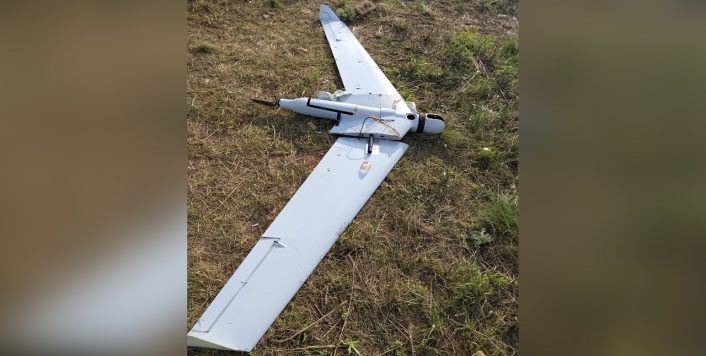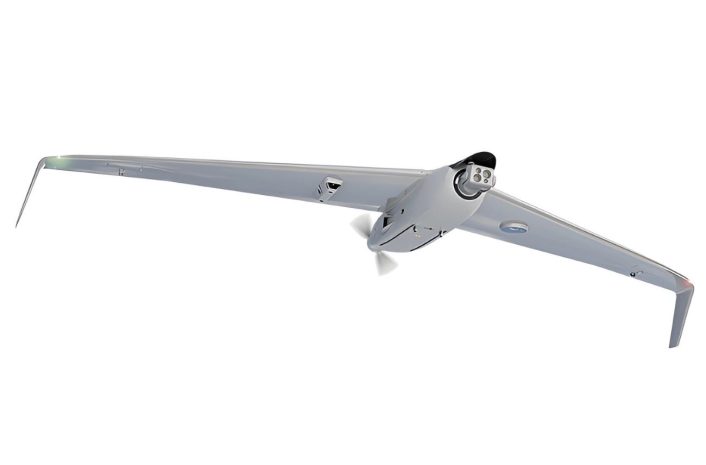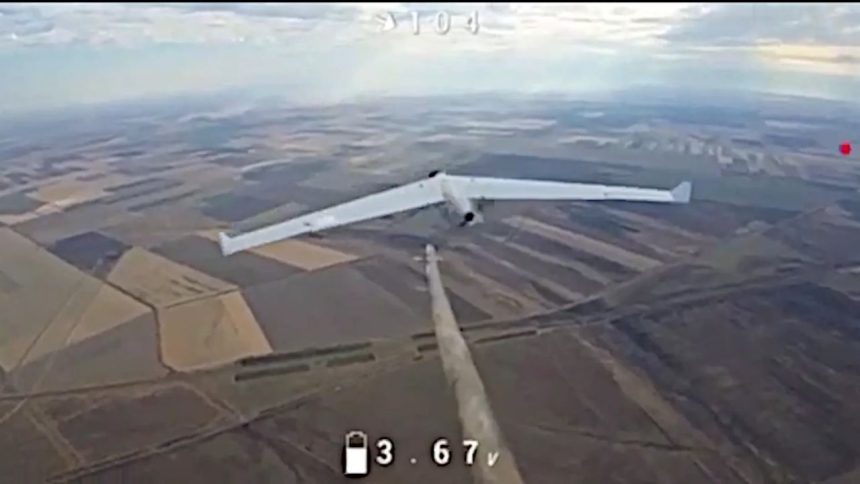Both Ukrainian and Russian armies are using their expendable UAVs not only to strike targets on the ground, but also to strike each others’ drones in flight, in what could be defined as a low-cost anti-UAV loitering munition concept.
With the proliferation of cheap, commercially available UAVs adopted by both sides, the Ukrainian front is now being characterized by frequent drone-on-drone wars. For an instance, an Ukrainian UAV armed with a stick, as seen in the nose camera footage recently emerged online, made multiple attempts to strike the propeller of a Russian ZALA 421-16E reconnaissance drone.
The assault is claimed to have disabled the engine of the flying-wing Russian drone, however in the video it’s not possible to evaluate the outcome of the attack. Such encounters are now becoming commonplace, with dozens of videos released by both sides damaging each other’s UAVs this way.
The ZALA 421-16E5 is a tactical drone, powered by a push-propeller used for simple elementary sector-sized ISR (Intelligence, Surveillance and Reconnaissance). Some Russian Telegram channels also claim it is capable of communications relay with a swappable internal module, in addition to the nose-mounted, gyro-stabilized EO (Electro-Optical) turret which includes a thermal imager and a high-definition TV/CCD camera.
A magic stick power!
🇺🇦 FPV drone repeatedly hit a russian ZALA UAV drone with a stick and disabled the drone engine.
📹: @SOF_UKR pic.twitter.com/xEULiqQI0o
— Defense of Ukraine (@DefenceU) July 25, 2024
The manufacturer claims it has a “hybrid propulsion” with both electric and internal combustion power plants, with a range of 150 km, flight endurance of 6 to 7 hours, and speeds between 80 and 125 km/h. The drone is launched via a pneumatic catapult and recovered with a deployable parachute.
The video of the “dogfight”
The video posted online by the Ukrainian Ministry of Defense shows the attacking Ukrainian UAV striking the ZALA drone from several angles – back, side and bottom. The video shows what appears to be a wooden stick protruding out in front of the camera, while the UAV flies around the ZALA closing the distance.
The drone then makes a high-speed attack, reaching under the Russian drone and ramming it. As the nose camera footage shows, the Ukrainian drone then spins out of control and it’s not possible to see what effect the attack had on the Russian drone.
The next video segment suggests there is another attacking UAV involved, as shown by the longer stick and the higher battery charge level. The drone is shown striking the propeller multiple times, with some attacks also hitting the wings.
The aftermath of the attack and the consequences to the Russian drone are not shown. Also, whether this footage belongs to the same engagement, with Ukraine using different drones to attempt taking out the ZALA (since the first one possibly crashed), or to different encounters is not known.

Other drone versus drone clashes
A video posted on X on May 23, 2024 showed a recording from a Russian drone striking what looks like a Ukrainian ‘bomber’ quadcopter UAV, with an explosive payload. The video cuts off into static after the two drones make contact.
Drone on drone combat. You gotta see it to believe it.
Ukraine vs Russia and may the best drone win. pic.twitter.com/RAD19dtTFL
— steve smith the anti-communist (@stevesmithsnoq) May 23, 2024
Another video, shared by Samuel Bendett, a leading robotics and UAV expert, showed thermal footage from a Russian Mavic drone striking Ukraine’s heavy Baba Yaga ‘bomber’ multirotor UAV. The Baba Yaga has emerged as the mainstay of Ukraine’s unmanned platforms used to bomb ground targets, with the Russians sharing several videos of troops jamming it, shooting it down or even striking it with their own drones.
The above mentioned footage is actually a recording from an overhead drone that shows the Baba Yaga coming down after reportedly being hit by the Russian Mavic. The latter is however seen only in the beginning as a small dot, moving towards the Baba Yaga.
Prior to that, on May 15, Bendett posted another video, this time possibly from an attacking UAV itself, showing its thermal footage recorded while closing in on a Baba Yaga from the top. The video then cuts off when the two drones make contact.
Russian Telegram channels are posting another drone vs. drone video – a Russian Mavic reportedly struck Ukraine’s Baba Yaga heavy drone. https://t.co/xSsMKT2ipX https://t.co/gTvsSowocz pic.twitter.com/4W4nEuZ4lj
— Samuel Bendett (@sambendett) May 23, 2024
Another popular OSINT profile posted a video showing three Ukrainian drone strikes, engaging a Russian Orlan-10/30 and two ZALAs. One of the ZALA drones is later seen crashed in a field.
AFU FPV drones from Magyar’s birds versus Russian reconnaissance drones.
Source: https://t.co/uwD0o1la62#OSINT #UkraineRussiaWar #UkraineWar #UkraineKrieg #Ukraine #Russia pic.twitter.com/EmhdKtBDR5
— OSINT (Uri Kikaski) 🇺🇸 🇨🇦 🇬🇧 🇺🇦 🇮🇱 (@UKikaski) June 15, 2024
Analysis
While the war first began with Ukraine and Russia using simple quadcopters to drop small bombs, usually hand grenades, on infantry groups and tanks, it progressed with Kyiv strapping explosives and RPG (Rocket-Propelled Grenade rounds on quadcopters and flying them into Russian tanks and armor. The two armies then acquired Chinese-origin DJI drones for simple battlefield surveillance and artillery fire correction.
With Ukraine’s evolving tactics integrating the use of off-the-shelf UAVs bought with donations towards its Army of Drones initiative and Russia fielding some commercial drones as well as products of its own defense and private industry, the unmanned aircraft of both countries often meet mid-air. And they literally clash!
Some of these are chance encounters, given the massive number of UAVs Ukraine floods the battlefield with, forcing Russian drone operators to simply ram their own UAVs into the other unmanned aircraft. But this use of a stick in this engagement suggests that Ukraine used a purpose-built UAV, fitting it with a stick to damage Russian drones without having to lose one of its own.

This could be happening especially because anti-drone systems and jammers are short in supply. And while many Russian units across the front have been photographed holding the hand-held jammers like the PARS or the EDM4S gun, it is impossible to match the scale and speed at which the Armed Forces of Ukraine (AFU) replenishes its drone stocks. Thus, both armies are using their expendable UAVs explicitly to also strike each others’ drones, in what is shaping up to be low-cost anti-UAV loitering munitions!
Conclusion
Drones had long been predicted to dominate future warfare two decades ago. But strategists conceived sophisticated unmanned systems semi-autonomously undertaking strike roles, overseen by cost-efficient small-sized armies and soldiers, packed with technology multiplying the capabilities of the individual combatant.
Naturally, the Russia-Ukraine war upturned that belief, giving new lessons that actually upheld traditional ones. In a conventional war, one needs mass and size, regardless of how advanced your own or the adversary army is or the duration of the war. The scale of UAV attrition on both sides in Ukraine bares this imperative.









